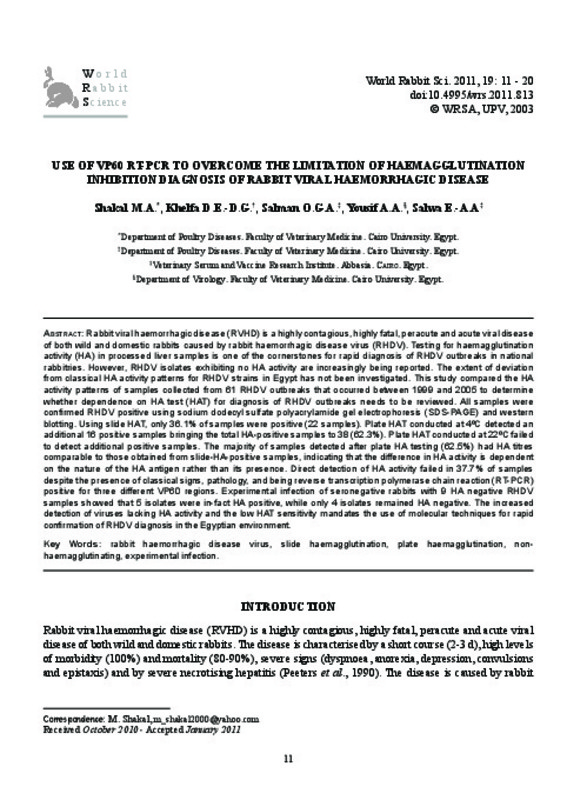JavaScript is disabled for your browser. Some features of this site may not work without it.
Buscar en RiuNet
Listar
Mi cuenta
Estadísticas
Ayuda RiuNet
Admin. UPV
Use of VP60 RT-PCR to overcome the limitation of haemagglutination inhibition diagnosis of rabbit viral haemorrhagic disease
Mostrar el registro sencillo del ítem
Ficheros en el ítem
| dc.contributor.author | Shakal, M.A.
|
|
| dc.contributor.author | Khelfa, D.E.-D.G
|
|
| dc.contributor.author | Salman, O.G.A.
|
|
| dc.contributor.author | Yousif, A.A.
|
|
| dc.contributor.author | Salwa, E.-A.A
|
|
| dc.date.accessioned | 2011-05-09T12:35:56Z | |
| dc.date.issued | 2011 | |
| dc.identifier.issn | 1257-5011 | |
| dc.identifier.uri | http://hdl.handle.net/10251/10903 | |
| dc.description.abstract | [EN] Rabbit viral haemorrhagic disease (RVHD) is a highly contagious, highly fatal, peracute and acute viral disease of both wild and domestic rabbits caused by rabbit haemorrhagic disease virus (RHDV). Testing for haemagglutination (HA) activity in processed liver samples is one of the cornerstones for rapid diagnosis of RHDV outbreaks in national rabbitries. However, RHDV isolates exhibiting no HA activity are increasingly being reported. The extent of deviation from classical HA activity patterns for RHDV strains in Egypt has not been investigated. This study compared the HA activity patterns of samples collected from 61 RHDV outbreaks that occurred between 1999 and 2005 to determine whether dependence on HA test (HAT) for diagnosis of RHDV outbreaks needs to be reviewed. All samples were confirmed RHDV positive using SDS-PAGE and western blotting. Using slide HAT, only 36.1% of samples were positive (22 samples). Plate HAT conducted at 4 0C detected an additional 16 positive samples bringing the total HA-positive samples to 38 (62.3%). Plate HAT conducted at 22 0C failed to detect additional positive samples. The majority of samples detected after plate HA testing (62.5%) had HA titres comparable to those obtained from slide-HA-positive samples, indicating that the difference in HA activity is dependent on the nature of the HA antigen rather than its presence. Direct detection of HA activity failed in 37.7% of samples despite the presence of classical signs, pathology, and being RT-PCR positive for three different VP60 regions. Experimental infection of seronegative rabbits with 9 HA negative RHDV samples showed that 5 isolates were in-fact HA positive, while only 4 isolates remained HA negative. The increased detection of viruses lacking HA activity and the low HAT sensitivity mandates the use of molecular techniques for rapid confirmation of RHDV diagnosis in the Egyptian environment. | es_ES |
| dc.description.sponsorship | This work was partially funded by the Veterinary Serum and Vaccine Research Institute, Abbasia, Cairo, Egypt, and by Faculty of Veterinary Medicine, Cairo University, Giza, Egypt. | |
| dc.language | Inglés | es_ES |
| dc.publisher | World Rabbit Science. ICTA. UPV | es_ES |
| dc.relation.ispartof | World Rabbit Science | |
| dc.rights | Reserva de todos los derechos | es_ES |
| dc.subject | Rhdv | es_ES |
| dc.subject | Slide haemagglutination | es_ES |
| dc.subject | Plate haemagglutination | es_ES |
| dc.subject | Rt-pcr | es_ES |
| dc.subject | Non-haemagglutinating | es_ES |
| dc.subject | Experimental infection | es_ES |
| dc.title | Use of VP60 RT-PCR to overcome the limitation of haemagglutination inhibition diagnosis of rabbit viral haemorrhagic disease | es_ES |
| dc.type | Artículo | es_ES |
| dc.date.updated | 2011-05-06T13:12:26Z | |
| dc.identifier.doi | 10.4995/wrs.2011.813 | |
| dc.rights.accessRights | Abierto | es_ES |
| dc.description.bibliographicCitation | Shakal, M.; Khelfa, D.; Salman, O.; Yousif, A.; Salwa, E. (2011). Use of VP60 RT-PCR to overcome the limitation of haemagglutination inhibition diagnosis of rabbit viral haemorrhagic disease. World Rabbit Science. 19(1):11-20. https://doi.org/10.4995/wrs.2011.813 | es_ES |
| dc.description.accrualMethod | SWORD | es_ES |
| dc.relation.publisherversion | http://doi.org/10.4995/wrs.2011.813 | |
| dc.description.upvformatpinicio | 11 | |
| dc.description.upvformatpfin | 20 | |
| dc.description.volume | 19 | |
| dc.description.issue | 1 | |
| dc.identifier.eissn | 1989-8886 | es_ES |
| dc.contributor.funder | Veterinary Serum and Vaccine Research Institute, Egipto | |
| dc.contributor.funder | Cairo University |








